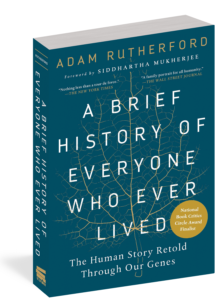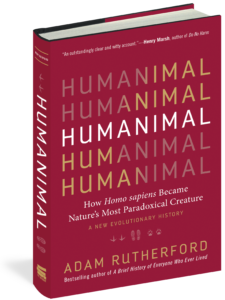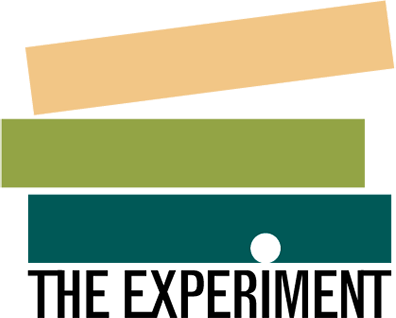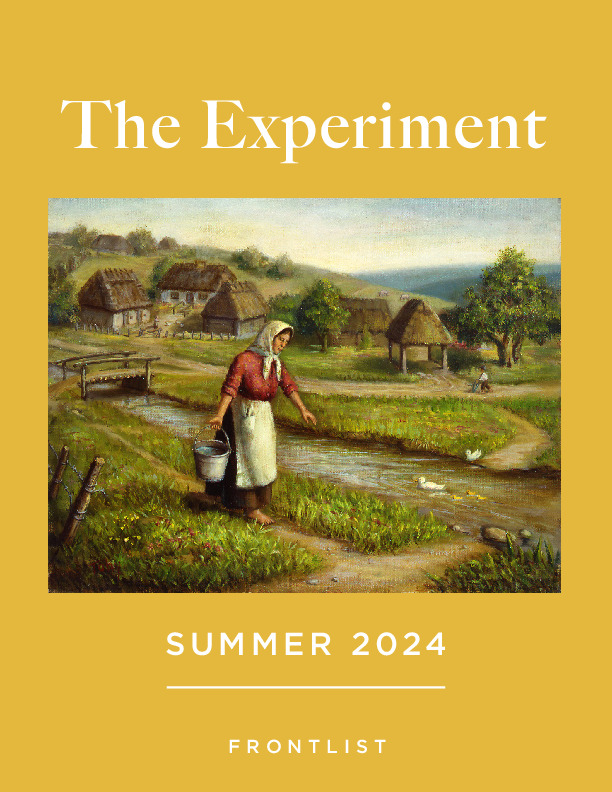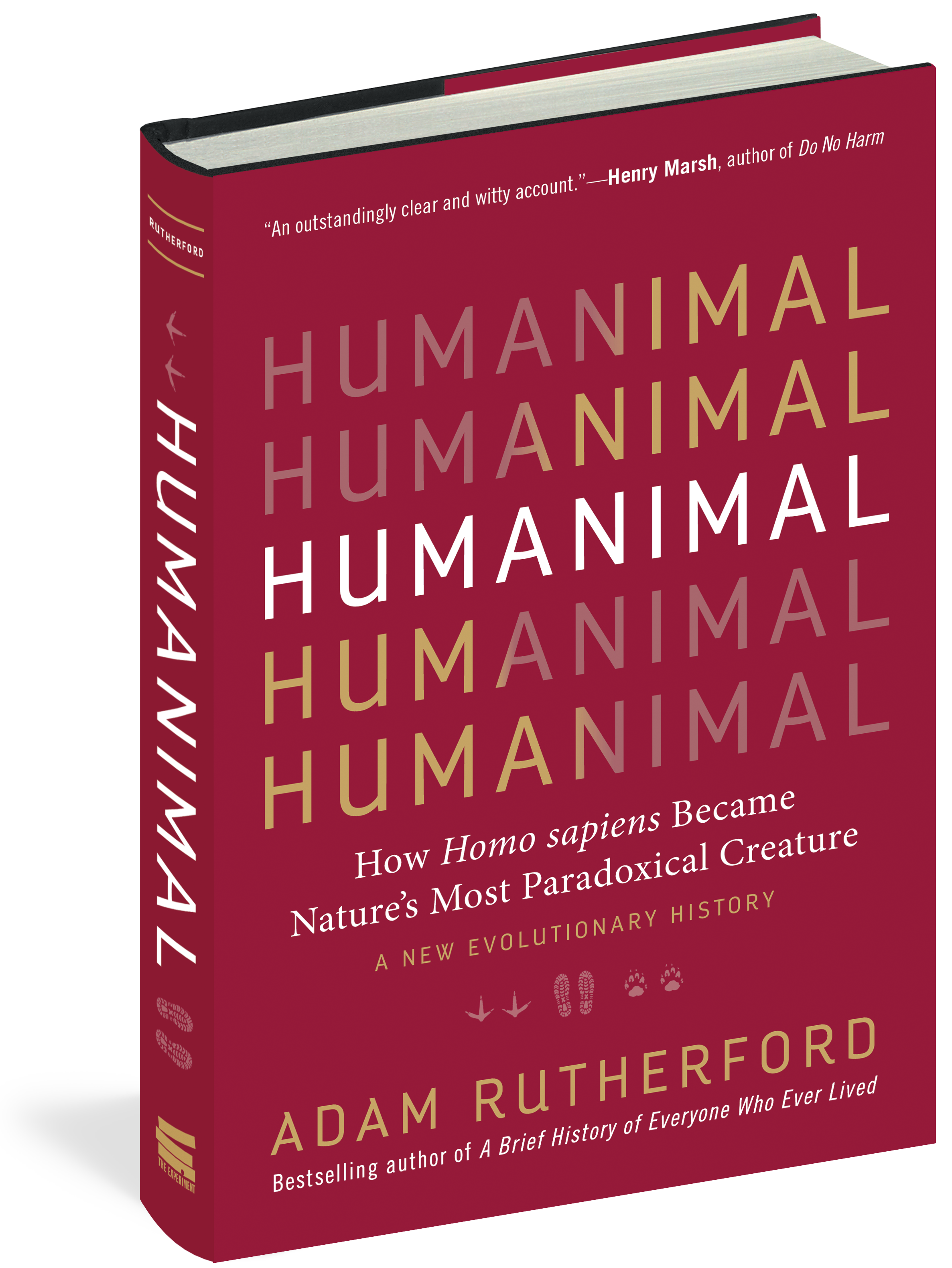
In 2017, A Brief History of Everyone Who Ever Lived published in North America, intertwining genetics and human history to answer the question of who we are and how we’re connected to one another. Now, best-selling author and geneticist Adam Rutherford takes on a new challenge and asks a very different question: what does it mean to be human, and are we more like animals than we think?
Publishing on March 19, Humanimal: How Homo sapiens Became Nature’s Most Paradoxical Creature—A New Evolutionary History offers up an entertaining tour of life on earth and explores the ways we’re different from animals—and the ways we aren’t. For example, did you know that we’re not the only species that communicates, makes tools, uses fire, or has sex for reasons other than procreation?
Adam is also coming to the US this March on a book tour for Humanimal. See below for dates and locations, and for more details, check out our events page.
Adam Rutherford March Book Tour:
- March 20 – The Strand (NYC)
- March 21 – Free Library of Philadelphia
- March 22 – Politics & Prose (DC)
- March 23 – Midtown Scholar Bookstore, (Harrisburg, PA)
- March 24 – Anderson’s (Chicago)
- March 25 – Highland Park Public Library (Chicago)
- March 26 – Porter Square Books (Boston)
- March 27 – McNally Jackson (NYC)
Read on for an exclusive excerpt from Humanimal, and don’t forget to pick up the book on March 19!

How noble in reason! How infinite in faculty!
In form, in moving, how express and admirable! In action how like an angel!
In apprehension how like a god! The beauty of the world!
The paragon of animals!
“The paragon of animals” is a lovely phrase. Hamlet exalts us as truly special, touching the divine, limitless in our thought. It’s a prescient phrase, too, as he raises us above other animals while acknowledging that we are one. Just over 250 years after William Shakespeare wrote those words, Charles Darwin irrefutably cemented humankind’s classification as an animal—the slightest of twigs on a single, bewildering family tree that encompasses four billion years, a lot of twists and turns, and a billion species. All of those organisms—including us—are rooted in a single origin, with a common code that underwrites our existence. The molecules of life are universally shared, the mechanisms by which we got here the same: genes, DNA, proteins, metabolism, natural selection, evolution.
Hamlet then ponders the paradox at the heart of humankind:
What is this quintessence of dust?
We are special, but we are also merely matter. We are animals, yet we behave like gods. Darwin sounds a bit like Hamlet, declaring that we have “god-like intellect,” yet we cannot deny that man—and, to bring his language into the twenty-first century, woman—carries the “indelible stamp of his lowly origin.”
This idea, that humans are special animals, is at the root of who we are. What are the faculties and actions that put us on a pedestal above our evolutionary cousins? What makes us animals, and what makes us their paragon? All organisms are necessarily unique, so that they can exist within and exploit their own unique environment. We certainly think of ourselves as pretty exceptional, but are we really more special than other animals?
Alongside Hamlet and Darwin comes a possible challenge to our ideas of human exceptionalism, from an arguably lesser piece of modern culture, the animated superhero film The Incredibles: “Everyone is special . . . which is another way of saying that no one is.”
Humans are animals. Our DNA is no different from anything that has lived in the last 4,000 million years. The coding system employed within that DNA is no different, either; the genetic code is universal as far as we know. The four coded letters that make up DNA (known as A, C, T, and G) are the same in bacteria and bonobos, orchids, oaks, bedbugs, barnacles, triceratops, Tyrannosaurus rex, eagles, egrets, yeast, slime molds, and ceps. The way they are arranged in those organisms, and how they are translated into the protein molecules that enact the functions of a living being, are all fundamentally the same, too. The fact that life is organized into discrete cells is also universal,* and these incalculably numerous cells harvest energy from the rest of the universe in a process common to all of them.
These principles are three of the four pillars of biology: universal genetics, cell theory, and chemiosmosis, which is a rather technical yet elegant word for the basic process of cellular metabolism—how cells draw energy from their surroundings, to be spent in the process of living. The fourth pillar is evolution by natural selection. Combined, these grand unifying theories coalesce to reveal something unarguable—that all life on Earth is related by common ancestry, and that includes us.
Evolution is slow, and the Earth has been host to life for the vast majority of our planet’s existence. The timescales we talk about so casually in science are utterly baffling to comprehend. Even though we are a latecomer to life on Earth, our species is more than 3,000 centuries old. We have traversed that ocean of time largely unchanged. Physically, our bodies are not drastically different from Homo sapiens in Africa 200,000 years ago.* We were physically capable of speaking then as we do today, and our brains were not significantly different in size. Our genes have responded in small part to changes in the environment and diets as we migrated within and out of Africa, and genetic variants account for the minuscule percentage of DNA that spells out the differences between individuals, changes in the most superficial characteristics—skin color, hair texture, and a few others. But if you tidied up a Homo sapiens woman or man from 200,000 years ago, gave them a haircut, and dressed them in twenty-first-century clothes, they would not look out of place in any city in the world today.
There’s a conundrum in that stasis. Though we may not look different, humans did change, and profoundly. There’s debate about when this transition occurred, but by 45,000 years ago, something had happened. Many scientists think that it was a sudden change—sudden in evolutionary terms means hundreds of generations and dozens of centuries, rather than a thunderbolt. We don’t quite have the language to relate to the timescales involved in such transitions. But what we can observe from the archaeological record is that we see the emergence and accumulation of a number of behaviors that are associated with modern humans, and there was a time before that where we see fewer or none of them. Given how long life has existed on Earth, this switch happened relatively in a heartbeat.
The transformation occurred not in our bodies or physiology or even in our DNA. What changed was culture. In scientific terms, culture refers broadly to the artifacts that are associated with a particular time and place. They include things like tools, blade technology, fishing gear, and use of pigment for decorative purposes or jewelry. The archaeological remains of a hearth show the ability to control fire, to cook, and maybe its position as a social hub. From material culture, we can infer behavior. From fossils we can try to piece together what people looked like, but with archaeological evidence of the paraphernalia of our ancestors’ lives, we can address what people were like in prehistory, and when they became like that.
By 40,000 years ago, we were designing decorative jewelry and musical instruments. Symbolism in our art was rife, and we were inventing new weapons and hunting technology. Within a few millennia, we had fostered dogs into our lives—tamed wolves that accompanied our search for food long before they became our pets.
The concatenation of these behaviors is sometimes referred to as the Great Leap Forward, as we jumped into a state of intellectual sophistication that we see in ourselves today. Alternatively, it’s a “cognitive revolution,” but I dislike the use of that phrase to describe a process that was both continuous and probably lasted a few thousand years or more—real revolutions should be thunderbolts. Nevertheless, modern behavior emerges permanently and quickly in several locations around the world. We began to carve complex figurines, both realistic and abstract, sculpted make-believe chimeras out of ivory, and we adorned cave walls with pictures of hunts and of animals important to our lives. The earliest piece of figurative art by Homo sapiens that we know of is a 40,000-year-old twelve-inch statue of a lean man with the head of a lion. It was carved from a mammoth tusk during the last Ice Age.
Nevertheless, a book is a thing that typifies the gap between us and all other beasts. It is the sharing of information generated by thousands of others, almost none of whom I am closely related to. I have studied their ideas and recorded them into a tool of almost unimaginable complexity, so that our minds might be enriched with this collection of stories that are new and hopefully interesting to anyone who cares to pick it up.
This is a book about the paradox of how we became us. It is an exploration of an evolution that bestowed enormous powers of intellect on an otherwise average ape, to create tools, art, music, science, and engineering. Through old bones and, nowadays, genetics, we know about the mechanics of our evolutionary journey through the eons (though there is so much still to discover), but we know far less about the development of our behavior, of our minds, and of the way that we uniquely evolved into the cultural and social beings that we are today.
To dive even deeper into the incredible similarities and differences between humans and animals, pick up your copy of Humanimal: How Homo sapiens Became Nature’s Most Paradoxical Creature—A New Evolutionary History on March 19, available wherever books are sold!

